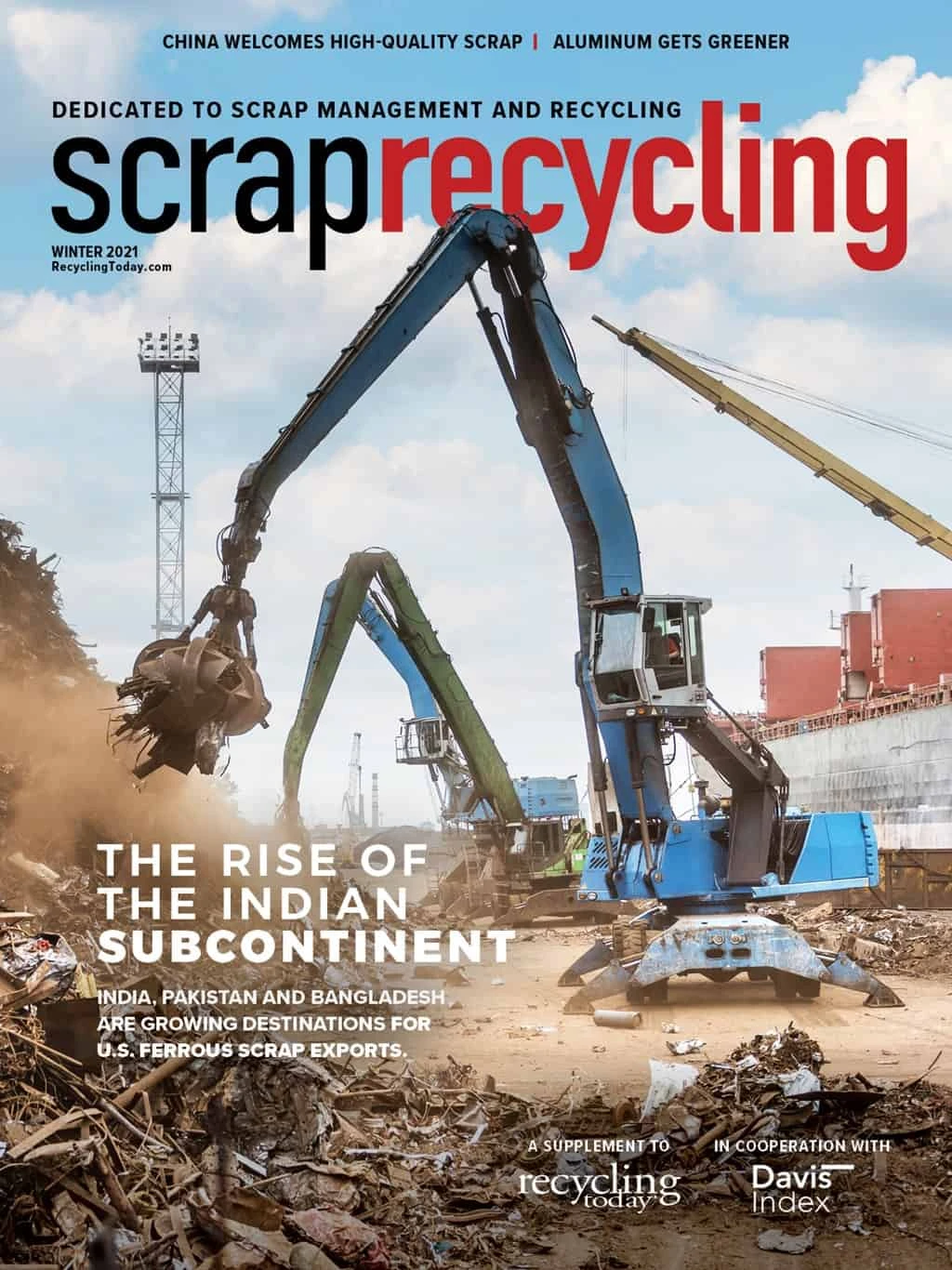
The arrival of the COVID-19 pandemic meant 2020 was an unprecedented year. Order and normality were replaced by chaos and uncertainty. With global events unfolding unpredictably daily, nobody knew what the months ahead had in store.
At the outset, the future looked grim, but gradually the needle began to point toward an emerging global recovery.
To attempt to understand what this year could promise for the copper market, we first need to review some of the fundamental forces that were at work in 2020 and consider how they could change.
A price roller coaster ride
On Dec. 1, 2020, the London Metal Exchange (LME) copper cash price hit its highest level since March 2013 as it closed at $7,675 per metric ton ($3.48 per pound). Copper charted an unlikely trajectory through 2020. Initially, prices plunged 27 percent from $6,301 per metric ton ($2.86 per pound) in January to a low of $4,617 per metric ton ($2.09 per pound) in late March as the global impact of COVID-19 became apparent.
But copper prices quickly stabilized and then began to rally, completing a full recovery to above and beyond their January 2020 starting point. As of early December of last year, the copper price had rallied 66 percent in just eight months from its March low, making it the most resilient of the LME base metals. What complex mix of forces explains the red metal’s stunning reversal of fortunes and its optimistic outlook?
Auto wiring harnesses were the worst affected product. Vehicle sales slumped, and wiring harness assembly plants, staffed by thousands of employees with little physical separation, became an ideal environment for spreading the virus. Reduced auto production also affected demand for electrical motor windings and connector strips.
Plumbing tube sales and building wire demand also were hit badly by reduced activity on construction sites at the height of the pandemic and destocking of the supply chain. By contrast, utility power cables, renewable energy projects and electric vehicle (EV) battery foil scarcely were affected by the recession.
In the world excluding China, consumption in 2020 was at its weakest in April and May (usually the seasonal peak), and thereafter began a sequential recovery, pausing only for August holidays in Europe.
Some fabricators in Italy, Malaysia and Brazil halted operations for several weeks as government movement- control orders made it impossible for them to run their businesses. In general, nationally, the number of infections correlated with the degree and length of economic disruption and the effect on underlying copper consumption.
Brazil, Mexico and India appear to have been the most severely affected and could see annual demand drop by more than 25 percent. They might take several years to recover to precrisis levels.
Almost every nation other than China will record a decline in copper consumption in 2020, with Roskill forecasting a total decrease of 10 percent.

Rebound possibilities
In China, the worst economic effects of the pandemic were concentrated in January and February. Thereafter, a strong sequential recovery took place from March to July across most end markets. This recovery began to lose a little momentum from August onward.
With China totally destocked as it entered 2020, and with some progress made in the trade war with the U.S., the sudden surge in wire and cable orders brought capacity utilization levels at cable making plants up to 100 percent by April, according to Shanghai Metals Market industry surveys.
This stimulated a rush in orders for wire rod to feed this requirement, which led to positive year-on-year growth in wire rod production from March to September. Major contributors to this were a 145 percent year-on-year explosion in investment on renewable wind power generation combined with other infrastructure spending. These factors, along with the commissioning of several new large wire rod plants that were ordered 12 to 18 months previously, are estimated to have resulted in total consumption growth of at least 4 percent to 5 percent.
The recovery in Chinese demand has been sufficient for its regional trading partners, Taiwan and South Korea, to record positive growth in copper demand in 2020. This leads Roskill to conclude that nations with the strongest trading links to China will be the fastest to recover economically in 2021. But China’s wider influence on the copper market has been far greater than its contribution to consumption.
After a 3 percent decline in world copper consumption in 2020, Roskill is expecting a healthy rebound of 5 percent in 2021. The rest of the world, chiefly Europe, Japan and North America, will be the main engine of the recovery, with year-on-year growth peaking in the second and third quarters as the normal seasonal pattern returns. Automotive (especially EVs), residential construction and renewable energy projects are forecast to be the best performing end-use sectors.
Looking ahead to 2021, Chinese growth will be positive but much lower than in 2020, probably peaking in the first half. Wind energy projects, air conditioning equipment and EVs probably will be the strongest end-use sectors. Much greater availability of imported scrap significantly will limit cathode demand expansion in China.
Supply-side turbulence
Roskill estimates that disruptions to global copper mine supply could have totaled between 750,000 to 1 million metric tons during 2020. Mines or smelters in Panama, Peru, Chile and the United States have had ongoing operational difficulties. (See the sidebar, “Digging into problems,” above.)
Because of the 2020 mine and smelter disruptions, global treatment charges and refining charges (TC/RCs) currently languish at multiyear lows. That circumstance reflects tight availability of clean concentrate compared with endemic global smelter overcapacity, with 750,000 metric tons of such capacity set to be commissioned in China next year alone.
Mine supply was not the weakest link in the global copper supply chain—it was international trade in scrap. Scrap is an integral part of global copper business, accounting for more than one-third of the total market through its contribution to supply and demand.
Recycling is a complex multistage business with people fulfilling a function at each step. You need people to collect it, buy it, sort it, process it, ship it and sell it. The lockdown blocked many links in this supply chain from operating effectively.
Beyond the supply hiccups, China—which previously imported half of the world’s scrap—imposed its quota system, serving to cut its red metal scrap imports by 50 percent in the first half of 2020.
In 2021, Roskill expects world scrap supply and international trade flows to normalize. Elevated copper prices should encourage scrap flows.
The new system permitting the unrestricted import of scrap (redesignated as a “resource” provided it meets a purity standard), meant to be introduced July 1, 2020, was delayed until Nov. 1, 2020, effectively extending the 50 percent quota system supply curtailment for four months.
Roskill estimates the quotas starved China of 300,000 metric tons (as measured by copper content) of scrap in 2020. The COVID-19 operating constraints and China’s blunt enforcement of quotas ensured that not only was the downturn in the international scrap trade more severe than for primary raw materials, it also was going to be more long-lasting, in fact throughout 2020. The latest data confirm a 26 percent year-on-year decline in world copper scrap imports in January to July 2020, including a 37 percent plunge in Q2.
Sponsored Content
Labor that Works
With 25 years of experience, Leadpoint delivers cost-effective workforce solutions tailored to your needs. We handle the recruiting, hiring, training, and onboarding to deliver stable, productive, and safety-focused teams. Our commitment to safety and quality ensures peace of mind with a reliable workforce that helps you achieve your goals.
In 2021, Roskill expects world scrap supply and international trade flows to largely normalize. Higher copper prices should encourage the release and flow of more scrap, which will be in high demand.
Teething problems are to be expected with China’s new import system, but these should gradually be overcome as experience is gained on both sides. Chinese secondary producers and fabricators are poised to aggressively expand their scrap imports in 2021 to replace the expensive cathode that they were compelled to buy in 2020 because of scrap supply shortages.
Calculating a price range
During 2020, several factors were important in determining the level and direction of copper prices. The first effects to be felt were the negative impact on demand, which resulted in a rise in cathode inventories on exchanges and in Chinese bonded warehouses until late March.
Prices slumped and, combined with the constraints posed by the virus and Chinese quotas, international trade flows in scrap constricted sharply. Then came the first indications of the spread of infections affecting mine output in the Americas.
The final stage began in June, when China dramatically accelerated its imports of refined copper to a level far beyond its immediate consumption capacity. After this continued for several months, it became clear that this was part of a deliberate restocking and strategic stockpiling effort involving the major trading houses and the State Reserve Bureau.
Roskill estimates that China could have accumulated 700,000 metric tons of “unreported” inventory in 2020, material that is now permanently denied to consumers elsewhere. This artificial tightening of the refined market drove prices steadily higher, with the weak U.S. dollar contributing to the rally in November.
After a $6,000 per metric ton ($2.72 per pound) average in 2019, copper likely will average $6,150 per metric ton ($2.79 per pound) in 2020—an exceptional outcome considering where the industry found itself in late March.
With LME prices trading at the rarefied heights of $7,600 per metric ton ($3.45 per pound) in early December 2020, it is not surprising to see some market commentators calling it a structural bull market with future price projections of $9,000 to $10,000 ($4.08 to $4.54 per pound).
However, with aluminum prices currently averaging a bit more than $2,000 per metric ton (91 cents per pound), substitution pressures would intensify quickly. Though very high prices cannot be discounted as a possibility, we believe it is an unlikely one.
Chinese cathode purchases certainly will slow in 2021, and the speed of the recovery in the rest of the world is uncertain.
Scrap often has been described as the “unseen hand” of the copper market. With its supply set to improve markedly after multiple constraints through 2020, we would not be surprised to see it constrain the upward movement in LME copper prices. Roskill forecasts that LME copper prices could average $7,400 per metric ton ($3.36 per pound) in 2021.
Get curated news on YOUR industry.
Enter your email to receive our newsletters.

Explore the Winter 2021 Scrap Recycling Issue
Check out more from this issue and find your next story to read.
Latest from Recycling Today
- Hindalco to invest in copper, aluminum business in India
- Recycled steel price crosses $500 per ton threshold
- Smithers report looks at PCR plastic’s near-term prospects
- Plastics association quantifies US-EU trade dispute impacts
- Nucor expects slimmer profits in early 2025
- CP Group announces new senior vice president
- APR publishes Design Guide in French
- AmSty recorded first sales of PolyRenew Styrene in 2024








